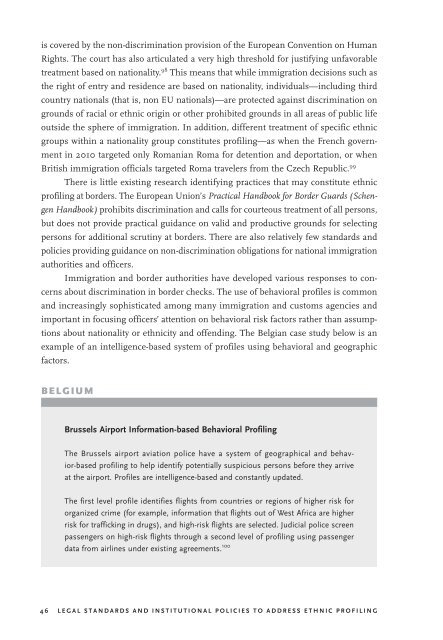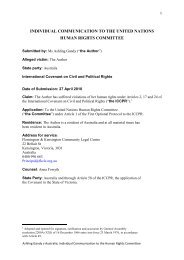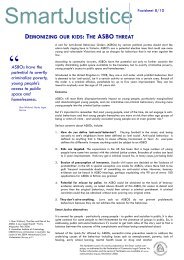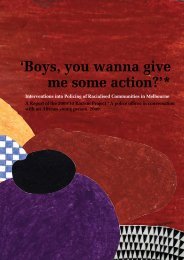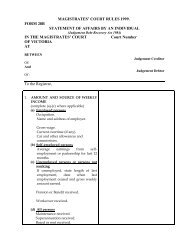Reducing Ethnic Profiling in the European Union - Open Society ...
Reducing Ethnic Profiling in the European Union - Open Society ...
Reducing Ethnic Profiling in the European Union - Open Society ...
- No tags were found...
You also want an ePaper? Increase the reach of your titles
YUMPU automatically turns print PDFs into web optimized ePapers that Google loves.
is covered by <strong>the</strong> non-discrim<strong>in</strong>ation provision of <strong>the</strong> <strong>European</strong> Convention on HumanRights. The court has also articulated a very high threshold for justify<strong>in</strong>g unfavorabletreatment based on nationality. 98 This means that while immigration decisions such as<strong>the</strong> right of entry and residence are based on nationality, <strong>in</strong>dividuals—<strong>in</strong>clud<strong>in</strong>g thirdcountry nationals (that is, non EU nationals)—are protected aga<strong>in</strong>st discrim<strong>in</strong>ation ongrounds of racial or ethnic orig<strong>in</strong> or o<strong>the</strong>r prohibited grounds <strong>in</strong> all areas of public lifeoutside <strong>the</strong> sphere of immigration. In addition, different treatment of specific ethnicgroups with<strong>in</strong> a nationality group constitutes profil<strong>in</strong>g—as when <strong>the</strong> French government<strong>in</strong> 2010 targeted only Romanian Roma for detention and deportation, or whenBritish immigration officials targeted Roma travelers from <strong>the</strong> Czech Republic. 99There is little exist<strong>in</strong>g research identify<strong>in</strong>g practices that may constitute ethnicprofil<strong>in</strong>g at borders. The <strong>European</strong> <strong>Union</strong>’s Practical Handbook for Border Guards (SchengenHandbook) prohibits discrim<strong>in</strong>ation and calls for courteous treatment of all persons,but does not provide practical guidance on valid and productive grounds for select<strong>in</strong>gpersons for additional scrut<strong>in</strong>y at borders. There are also relatively few standards andpolicies provid<strong>in</strong>g guidance on non-discrim<strong>in</strong>ation obligations for national immigrationauthorities and officers.Immigration and border authorities have developed various responses to concernsabout discrim<strong>in</strong>ation <strong>in</strong> border checks. The use of behavioral profiles is commonand <strong>in</strong>creas<strong>in</strong>gly sophisticated among many immigration and customs agencies andimportant <strong>in</strong> focus<strong>in</strong>g officers’ attention on behavioral risk factors ra<strong>the</strong>r than assumptionsabout nationality or ethnicity and offend<strong>in</strong>g. The Belgian case study below is anexample of an <strong>in</strong>telligence-based system of profiles us<strong>in</strong>g behavioral and geographicfactors.BELGIUMBrussels Airport Information-based Behavioral <strong>Profil<strong>in</strong>g</strong>The Brussels airport aviation police have a system of geographical and behavior-basedprofil<strong>in</strong>g to help identify potentially suspicious persons before <strong>the</strong>y arriveat <strong>the</strong> airport. Profiles are <strong>in</strong>telligence-based and constantly updated.The first level profile identifies flights from countries or regions of higher risk fororganized crime (for example, <strong>in</strong>formation that flights out of West Africa are higherrisk for traffick<strong>in</strong>g <strong>in</strong> drugs), and high-risk flights are selected. Judicial police screenpassengers on high-risk flights through a second level of profil<strong>in</strong>g us<strong>in</strong>g passengerdata from airl<strong>in</strong>es under exist<strong>in</strong>g agreements. 10046 LEGAL STANDARDS AND INSTITUTIONAL POLICIES TO ADDRESS ETHNIC PROFILING


